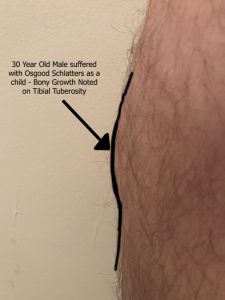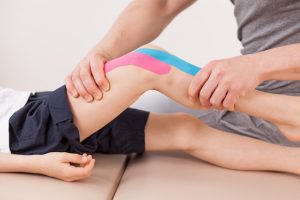In this post, you will learn everything that you need to know about Osgood-Schlatter disease, which is a condition that will cause swelling and associated pain below the knee joint. This can be attributed to issues with the patellar tendon, which stretches over the kneecap, but there may also be other problems at play too. Osgood-Schlatter disease is concerned with where the knee joint attaches to the top of the shinbone, or tibia, which is the spot on the body known as the tibial tuberosity. We’ll take you through what it means for you and your child and how a Paediatric Physiotherapist can help your child get rid of it.
What is Osgood Schlatter Disease?
Osgood Schlatter disease is one of the most common causes of knee pain in a growing child, it is especially common among the ages of 10-15 years old. It is an inflammation of the area below the knee where the tendon from the kneecap (patellar tendon) attaches to the shinbone (tibia). The strong thigh muscles (quadriceps) repetitive contractions disrupt the attachment site on the Tibia causing inflammation of the growing area of the Tibia Bone (Shin Bone).
Pathophysiology
The area of the bones where it grows in Children is known as a Growth Area. It is an area of cartilage at the end of the bones. As a child gets older, the growth plates disappear and form a solid bone.
It is caused when the large muscles on the front of the thigh (quadriceps) pull on the patella tendon which encases the Kneecap (patella). The patella tendon attaches to a bony prominence just below the knee called the tibial tuberosity. So whenever a child is involved in activities like walking, jumping and running, the quadriceps muscles contract and pull on the tibial tubercle. Sometimes this repetitive contraction of the muscles leads to inflammation in the tendon at the insertion and the growth plate – Which leads to a condition called Osgood-Schlatter Disease.
The more explosive and weight baring the activity is on the knee, the more likely a child is to get Osgood-Schlatters.

Signs and symptoms
- Pain in the knee, around the bony part of the top of the shin bone (tibial tuberosity), and around the patellar tendon.
- Activities like jumping, running, kneeling, and squatting aggravates the pain.
- Local Swelling at the tibial tubercle area (Bony prominence below the knee)
- Quadriceps muscles tightness
- Quadriceps muscle weakness
A Paediatric Physiotherapists Approach
Physiotherapy plays a great role in managing Osgood Schlatter’s disease. And non-operative physiotherapy treatment has shown great outcomes.
Following are how a Physiotherapists approach can help benefit in treating your child’s knee pain.
1. Knee Protection
- Proper resting period and position
- Refrain from activities that cause the knee pain
- May prescribe knee support/ brace for protection of the knee/ Kinesiology tape

2. Give advice
Advice on using an ice pack when sore or just after activity. Advice and education on initially reducing the amount of activity your child does to help gradually increase and return to normal levels of activity. The advice and tips you can learn for your child from seeing a specialist paediatric physiotherapist can really speed up the recovery rate for your child.
3. Stretching exercises
One of the common reasons for developing Osgood Schlatter’s disease is excessively tight quadriceps muscles, ITB, hamstrings, hip flexors and calf muscles. Your Child’s physiotherapist will prescribe relevant stretching exercises for the affected lower limb to loosen up your Child’s muscles so they stop pulling so tightly on the bone.
4. Strengthening exercises
The weak muscles can cause Osgood Schlatter disease or Osgood Schlatter disease can weaken the muscles, it’s vice versa. Whatever the case, your child’s Physiotherapist will prescribe various ways and exercises to strengthen the weak Quadriceps muscles.
5. Foot Orthotics
Sometimes foot conditions like a flat foot or inadequate positioning technique of your Child’s foot during sports and activities can lead to knee pain. Well, a Physiotherapist will examine, assess and study whether it is the foot that is the cause. If this is deemed the case, an appointment can be arranged with our expert Biomechanical consultant who can prescribe a Foot Orthotic / insole to correct the improper positioning of the foot that causes Osgood Schlatter disease.
6. Soft Tissue therapy / manual therapy
The muscles surrounding the knee joint, (especially the quadriceps muscles which attach to the bony part where osgood schlatters disease is visible) can get very tight with thickening and trigger points throughout the muscle. Manual therapy and soft tissue therapy (massage, Trigger point therapy, Neuromuscular techniques, Muscle Energy techniques) can all be a great way of helping the muscle return to a more normal length and function allowing them to pull less and relieve pressure off the attachment sites on the bone.
Conclusion
In this article, you have learned all the aspects and how Paediatric Physiotherapist can approach getting rid of your Child’s Knee pain.
Now next thing you need to do is contact your nearest Physiotherapy Clinic and consult a Physiotherapist. If you are residing in Chelmsford, Essex, you know where to go and who to contact.
Here at Faye Pattison Physiotherapy we have a Specialist Paediatric Physiotherapist who is extremely experienced in dealing with children diagnosed with Osgood-Schlatter’s Disease.
Call 01245 690520 today or book your appointment.





